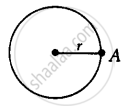Advertisements
Advertisements
प्रश्न
The displacement of a moving object in a given interval of time is zero. Would the distance travelled by the object also be zero? Justify your answer.
उत्तर
In a given interval of time, the displacement of a moving object is zero when its final position is the same as the initial position, whereas the distance travelled by the object is not zero. For example, an athlete moving on a circular track. If he starts from A and completes one round and reaches back to point A, his displacement is zero whereas the distance travelled by him is not zero but 2πr.

APPEARS IN
संबंधित प्रश्न
State whether distance is a scalar or a vector quantity.
Clarify the difference.
Distance and displacement
Define displacement. State its unit.
The following table gives the displacement of a car at different instants of time.
| Time (s) | 0 | 1 | 2 | 3 | 4 |
| Displacement (m) | 0 | 5 | 10 | 15 | 20 |
- Draw the displacement-time sketch and find the average velocity of the car.
- What will be the displacement of the car at (i) 2.5 s and (ii) 4.5 s?
From the displacement-time graph of a cyclist given below in the Figure, find The displacement from the initial position at the end of 10 s,

Write an expression for the distance S covered in time t by a body which is initially at rest and starts moving with a constant acceleration a.
When brakes are applied to a bus, retardation produced is 25 cm s-2 and the bus takes 20 s to stop. Calculate -
- The initial velocity of the bus
- The distance travelled by bus during this time.
Is distance covered during nth second more than the distance covered in n seconds?
Match the following.
| 1. | Displacement | Knot |
| 2. | Light travelling through vacuum | Geometric centre |
| 3. | Speed of ship | Metre |
| 4. | Centre of gravity of geometrical shaped objects | Larger base area |
| 5. | Stability | Uniform velocity |
Give some examples for vector quantity.
